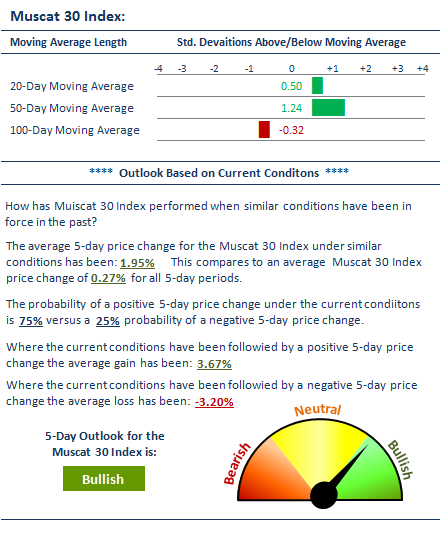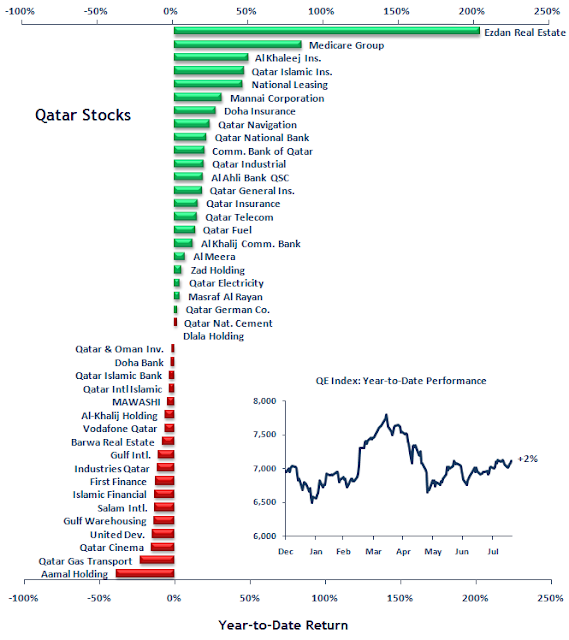The advance/decline percentage is calculated on a daily basis and determines the proportion of stocks that are rising in value versus falling in value. The specific calculations is as follows:
Advance/Decline % = (# of Advancing Stocks - # of Declining Stocks) / # of Stocks
For example, if we have a hypothetical market that comprises of 10 stocks and 7 of these stocks have risen in value on a particular trading day then the advance/decline percentage will be:
(7 - 3) / 10 = 40%
This tells us that 40% more stocks were increasing in price than were decreasing in price. Alternatively, if a majority of stocks have fallen in value, say 8 stocks, then the advance/decline percentage will be:
(2 - 8) / 10 = -60%
In this case there were 60% fewer stocks rising in value than were falling in value.
So, as you can see, if the advance/decline percentage is greater than zero a majority of stocks are rising in value and if it is below zero a majority of stocks are falling in value. The zero level represents equality between the number of rising and falling stocks.
Because the daily advance/decline percentage moves very fast it is typical to use a moving average to smooth the results. For this series of posts I've applied a 20-day moving average to the raw daily advance/decline percentages.
Below is a chart of the DFM General Index and corresponding advance/decline indicator.
As you can see, the 20-day advance/decline indicator oscillates around the zero level (right axis). When the advance/decline indicator is above zero (green shaded area) this signifies that a greater number stocks are rising in value than falling. The more the indicator rises above the zero level the greater the proportion of stocks that are rising versus falling.
When the advance/decline indicator is below zero (red shaded area) this signifies that a majority of stocks are falling in value. The further the indicator is below zero the greater the proportion of stocks that are falling versus rising.
As you might expect, when the DFM General Index has been rallying it has been accompanied by a positive 20-day advance/decline percentage. In bear markets the 20-day advance/decline percentage tends to be negative with a majority of stocks falling in value.
There are two main ways to interpret and use the advance/decline indicator. The first is to use extreme advance/decline levels as an indicator of potential market turning points. The logic here is that when a very high percentage of stocks are participating in a market move this is unsustainable and will be followed by a market reversal.
The other main use is to look for divergences between the advance/decline indicator and market prices. For example, if market prices are making new lows but the advance/decline indicator is not then this might signify a bottom for the market and higher future prices. The logic behind this use of the advance/decline indicator is that where fewer stocks are participating in a market decline this shows a lack of support for that move and a likely turning point. The opposite is true for rising markets.
In future posts I will examine the validity of both uses of the advance/decline indicator on GCC equity markets. To begin with, however, I've tested a simpler use of the indicator which has yielded positive results across all GCC markets.
The chart below shows the performance of the DFM General Index under different advance/decline conditions:
 |
| (Note: Results are uncompounded and do not include fees or dividends) |
I arbitrarily chose these rules but they seemed quite intuitive (to me at least). My reasoning was that if a majority of stocks were participating in a market rally and the number of stocks participating was increasing this would be bullish for the future price direction. On the other hand, if a majority of stocks were participating in a market decline and the number of stocks participating is that decline was increasing this would be bearish for future price direction.
The results above show that these simple rules were reasonably effective in identifying periods of increasing and decreasing market prices. The future performance of the DFM General Index when the advance/decline indicator was positive and higher than two weeks ago was bullish (green line). However, the future performance of the DFM General Index tended to be bearish when the advance/decline indicator was negative and lower than it was two weeks ago (red line).
These results were fairly consistent across all GCC markets and I'll present them in Part II. In Part III of the market breadth series I'll introduce a study which I'll use ongoing basis to monitor the advance/decline indicator and it's implications for future market price action.
Enjoy.





















































